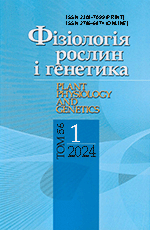During morphogenesis of leaves influence of heavy metals on the intensity of lipid peroxidation prоcesses and changes in the content of components of the cuticle surface layer of the woody plants leaves was studied. It was found that under conditions of industrial pollution in the leaves of Populus italica at high phytoextraction potential free-radical processes slightly activated (by 1.7 times). Also total amount of the surface cuticular lipids increased, while their heterogeneity decreased, which can be regarded as a type of adaptive responses of species. The above leads to its high physiological resistance to the conditions of excessive industrial pollution. In the leaves of Betula pendula with negligible accumulation of heavy metals content of TBA-active products increased more than 2.7 times, while the quantity of surface lipids decreased, which indicates a low ability of this species to adapt to changed environmental conditions. However, against decrease in amounts of diglycerides and phospholipids the level of lipid compounds heterogeneity in B. pendula leaves increased by fractions of free fatty acids and sterols, which are likely have been used to stabilize the cuticular layer at pollution conditions.
Keywords: woody plants, heavy metals, TBA-active products, lipids, adaptation
Full text and supplemented materials
Free full text: PDFReferences
1. Berzenina O.V., Shtemenko N.I. & Shepelenko, V.M. (2002). Methods of investigation of surface lipids of plants. Visnyk Dnipropetrovskogo universitetu. Biolohiia, ekolohiia, 1(10), pp. 104-108 [in Ukrainian].
2. Buharina, I.L., Zhuravleva, A.N. & Bolyishova, O.G. (2012). Urban plantings: the environmental aspect. Izhevsk: Izd-vo Udmurtskiy universitet [in Russian].
3. Vetchinnikova, L.V., Kuznetsova, T.Yu. & Titov, A.F. (2013). Features of the accumulation of heavy metals in the leaves of woody plants in urban areas in the North. Trudyi Karelskogo nauchnogo tsentra RAN, No. 3, pp. 68-73 [in Russian].
4. Gryshko, V.M. & Piskova, O.M. (2014). Features of accumulation of heavy metals in leaves of tree plants with aerogenic contamination of ecotopes. Introduktsiya roslyn, No. 1(61), pp. 93-100 [in Ukrainian].
5. Gryshko, V.M., Syschykov, D.V. & Piskova, O.M. (2012). Heavy metals: input into soils, plant translocation and environmental hazards. Donetsk: Donbass [in Ukrainian].
6. Dospekhov, B.A. (1985). Field Experience Method. Moskow: Agropromizdat [in Russian].
7. Erofeeva, E.A. & Naumova, M.M. (2010). Interrelation of physiological and morphological indicators of a birch leaf plate hanging with the content of heavy metals in it. Vestnyk Nizhegorodskogo universiteta im. N.I. Lobachevskogo, No. 1, pp. 140-143 [in Russian].
8. Ylin, V.B. & Stepanova, M.D. (1979). Relative indicators of pollution in the soil-plant system. Pochvovedenie, No.11, pp. 61-67 [in Russian].
9. Keyts, M. (1975). Lipidology Technique. Per. from English. Moskow: Mir [in Russian].
10. Kopylova, L.V. (2012). The accumulation of heavy metals in woody plants in the urban areas of Eastern Transbaikalia (Unpublished or Kandidat thesis). Ulan-Ude [in Russian].
11. Guidelines for the determination of heavy metals in soils of farmland and plant products. (1989). Moskow [in Russian].
12. Morgun, V.V. (2009). Preface. Fiziologiya roslyn: problemy ta perspektyvy rozvytku. Kyiv: Logos, Vol. 2, pp. 7-11 [in Ukrainian].
13. Musienko, M.M., Parshykova, T.V. & Slavniy, P.S. (2001). Spectrophotometric methods in the practice of physiology, biochemistry and plant ecology. Kyiv: Fitosotsiotsentr [in Ukrainian].
14. Smirnov, O.E. & Taran, N.Yu. (2013). Phytotoxic effects of aluminum and mechanisms of alumina resistance of higher plants. Plant physiology and genetics, 45(4), pp. 281-289 [in Ukrainian].
15. Taran, N.Yu., Okanenko, O.A. & Batsmanova, L.M. (2009). The role of sulfochinovazyldiacylglycerol in adaptive reactions of Triticum aestivum L. on oxidation stress. Fiziologiya roslyn: problemy ta perspektyvy rozvytku. Kyiv: Logos, Vol. 2, pp. 233-238 [in Ukrainian].
16. Chupahina, G.N., Maslennikov, P.V. & Maltseva, E.Yu. (2011). Antioxidant status of plants in conditions of cadmium contamination of the urban environment. Vestnik Baltiyskogo federalnogo universiteta im. I. Kanta, Iss. 7, pp. 16-23 [in Russian].
17. Buschhaus, Ch. & Jetter, R. (2011). Composition differences between epicuticular and intracuticular wax substructures: How do plants seal their epidermal surfaces? J. Exp. Bot., 62, No. Moskow 3, 841-853. https://doi.org/10.1093/jxb/erq366
18. Emamverdian, A., Ding, Y., Mokhberdoran, F. & Xie, Y. (2015). Heavy metal stress and some mechanisms of plant defense response. The Scientific World J., Article ID 756120, 18 p. https://doi.org/10.1155/2015/756120
19. Greenderg, Ch.S. & Gaddock, Rh.R. (1982). Rapid single step membrane proteine assay. Clin. Chem., 28, No. 7, pp. 1726-1728.
20. Joo, J.H., Wang, S., Chen, J.G., Jones, A.M. & Fedoroff, N.V. (2005). Different signaling and cell death roles of heterotrimeric G protein a and b subunits in the Arabidopsis oxidative stress response to ozone. Plant Cell., No. 17, pp. 957-970. https://doi.org/10.1105/tpc.104.029603
21. Petrova, S., Yurukova, L. & Velcheva, I. (2014). Possibilities of using deciduous tree species in trace element biomonitoring in an urban area (Plovdiv, Bulgaria). Atmospheric Pollution Research, 5, pp. 196-202. https://doi.org/10.5094/APR.2014.024
22. Sebestiani ,L., Francini, A., Romeo, S. & Ariani, A. (2014). Heavy metals stress on poplar: molecular and anatomical modifications. Approaches to Plant Stress and Their Management. Ed.: R.K. Gaur, P. Sharma. Springer India, pp. 267-279. https://doi.org/10.1007/978-81-322-1620-9_15
23. Yang, Z. & Chu, C. (2011). Towards understanding plant response to heavy metal stress. Abiotic Stress in Plants. Mechanisms and Adaptations, 180 (2), pp. 59-78. https://doi.org/10.5772/24204
